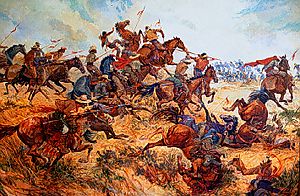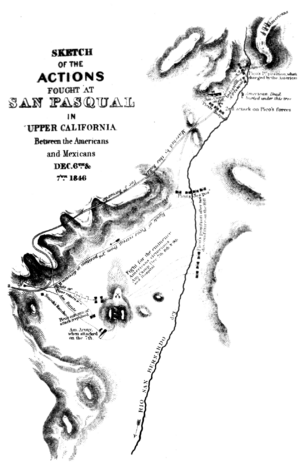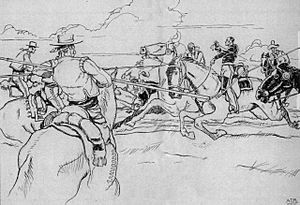Battle of San Pasqual facts for kids
Quick facts for kids Battle of San Pasqual |
|||||||
|---|---|---|---|---|---|---|---|
| Part of the Conquest of California Mexican–American War |
|||||||
 Battle of San Pasqual, Charles Waterhouse |
|||||||
|
|||||||
| Belligerents | |||||||
| Commanders and leaders | |||||||
| Strength | |||||||
| 150 | 75 | ||||||
| Casualties and losses | |||||||
| 18 killed 13 wounded |
12 wounded 1 captured |
||||||
The Battle of San Pasqual was a fight during the Mexican–American War. It happened in what is now the San Pasqual Valley near San Diego, California. This series of small battles took place on December 6 and 7, 1846. General Stephen W. Kearny led the U.S. Army of the West. He was joined by a small group of Marines. They fought against a group of Californios, who were Mexican residents of California. These Californios were led by Major Andrés Pico. Both sides claimed victory, and historians still debate who truly won. After more U.S. troops arrived, Kearny's forces finally reached San Diego.
Contents
Why Did the Battle of San Pasqual Happen?
Following a clash between U.S. and Mexican forces, Colonel Stephen Watts Kearny was promoted. He became a brigadier general. His mission was to take control of New Mexico and California. He also had to set up new governments there. Kearny was told to make friends with the local people.
Kearny's first group had 300 regular soldiers and 1,000 volunteers. He also had the Mormon Battalion. He marched from Fort Leavenworth to New Mexico. New Mexico surrendered without a fight. In Santa Fe, Kearny built Fort Marcy.
Kearny's Long March to California
On his way from New Mexico, Kearny met Native American tribes. He also captured a Mexican messenger. This messenger had news that Californios had already surrendered. Commodore Sloat had taken much of Alta California. Kearny was supposed to take command of U.S. forces in California.
However, he sent most of his troops back. He met Kit Carson near Socorro on October 6. Carson told him that Commodore Robert F. Stockton had already taken California. Kearny kept only about 100 men, mostly 1st Dragoons. His group was very tired and weak when they reached California on December 2. They had just finished a 2,000-mile march. This was one of the longest marches in U.S. Army history.
Who Was in Kearny's Army?
General Kearny's army included several key officers. Captain Abraham Robinson Johnston was an adjutant. Captain Benjamin Daviess Moore led Company C. Lieutenant William H. Emory was the chief engineer. Lieutenant John W. Davidson commanded two howitzers (small cannons). Dr. John S. Griffin was the army surgeon. Many enlisted men were also part of the force.
These officers kept journals during their journey. Lieutenant Emory's journal was the official U.S. Government diary. It was published in 1848.
Californio Forces Gather
After the Battle of Dominguez Rancho, Captain Jose Maria Flores sent troops to stop the Americans. He sent about 100 men to San Luis Obispo. These men were to face Lt. Col. John C. Fremont's 300 men. Flores also sent 100 men to watch Stockton's base in San Diego. Most of his men stayed in Los Angeles.
Captain Archibald Gillespie and 39 men met Kearny on December 5. Gillespie brought a message from Stockton. Stockton asked Kearny to fight Flores' men near San Diego. The total American force now had 179 men.
Who Was in Gillespie's Group?
Lieutenant Gillespie's group included 10 U.S. Navy riflemen. They were from the Pacific Coast fleet. They also had a Russian brass cannon from Sutter Fort. This cannon had been hidden after a tax revolt. Twenty-six mounted riflemen were also with Gillespie. They were led by Acting-Captain Samual Gibson and Acting-Lieutenant Alexis Godey. Antoine Robidoux was their interpreter. Rafael Machado, a Californio guide from San Diego, also joined them.
Captains Leonardo Cota and Jose Alipaz led a Californio force to San Pasqual Valley. They wanted to stop Gillespie. Later, Major Andrés Pico joined them and took command. These Californios were landowners, their sons, and vaqueros (cowboys). Many had well-known family names. On the night of December 5, a Native American told the Californios about Kearny's forces.
What Happened Before the Battle?
A U.S. patrol led by Lieutenant Thomas C. Hammond scouted Pico's force. Rafael Machado guided them. Machado was the son of a local landowner. He was helping Kearny.
While Machado was scouting, Lieutenant Hammond became suspicious. He rode his dragoons into the Californio camp. They found an Indian sleeping in a hut. A guard, Captain Jose Alipaz, challenged the dragoons. This alerted the camp. Machado quickly returned to Hammond's group. Alipaz sounded the alarm, but General Pico didn't believe him at first. Then, a U.S. Army blanket and coat were found. Pico was alerted, and the Californio camp got ready for an attack.
Kearny had planned a surprise attack at dawn. But the weather was damp, making their gunpowder wet. The soldiers' equipment and mounts were also in poor condition. Most of their horses had died, so they rode mules.
How Did the Battle Unfold?
Kearny had lost the element of surprise. At midnight, he ordered an immediate advance from his camp. It had rained, and everything was wet and cold. But the troops were ready to fight. Early on December 6, 1846, the column moved towards San Pasqual. It was still dark and foggy. Kearny's force became spread out. General Pico's swift advance caught them in a bad position. Kearny's plan was to surround San Pasqual and capture fresh horses.
Captain Abraham R. Johnston's advance guard was ordered to "Trot!" by Kearny. Johnston misunderstood and ordered "Gallop!". Forty of the fastest riders went far ahead of the main group. This went against their cavalry rules. The mules pulling the cannons also ran off. Pico's mounted force stayed ahead of the Americans. Their fresh horses and riding skills allowed them to outmaneuver the dragoons. The Californios knew the land much better.
The damp gunpowder made carbines useless as guns. They were used like clubs. Pistols were like hammers. The Californios used long lances and reatas (ropes). They used these very effectively. Johnston's charge failed, and his dragoons had to retreat.
As the U.S. forces got close to a Kumeyaay village, the Californios turned back. They fired their few guns. Captain Johnston was killed by a bullet. Pico then moved his forces half a mile to higher ground.
Captain Benjamin D. Moore ordered a second charge. This separated the Americans even more. The Californios met his dragoons with a counter-charge of lancers. Moore's charge was quickly surrounded, and he was killed. Gillespie arrived with the artillery (cannons) about fifteen minutes later. Mules are hard to turn, and the Californios outflanked the Americans. They captured one of the cannons.
Gillespie fought off a fierce attack by lancers. Kearny was wounded by a lance. Other dragoons were pulled off their mounts, tied up, and lanced by Californio teams. Gillespie's men fired their remaining cannon. They used canister shot, which is like a giant shotgun blast. This drove the Californio fighters away. The U.S. forces then set up a camp on a hill. They buried their dead outside the camp that night. This camp is now inside the San Diego Zoo Safari Park.
Historian Owen Coy said the Americans fought bravely. But their mules were hard to control, and their swords were too short. He also noted that the Americans were in a very bad situation.
What Happened After the Battle?
Messengers Seek Help
On December 7, 1846, Captain Turner took command of the Dragoons. Kearny was wounded. They marched towards San Diego. Californio lancers blocked their path near "Mule Hill." Captain Turner ordered Lieutenant William H. Emory to drive them off. With dry gunpowder, the dragoons easily forced the lancers away. Five Californios were killed.
That evening, Captain Turner set up a strong defense. He sent messengers to Commodore Stockton asking for help. Alexis Godey, Thomas Burgess, and another man carried the messages. On December 8, there was still no word. Then, the Californios offered to trade prisoners. The Americans only had one prisoner, Pablo Vejar. After the trade, the Americans learned Stockton had no horses. He could not send help.
Kearny, recovering from his wounds, decided to send more messengers. That night, Lieutenant Beale, Scout Carson, and an Indian guide named Pontho volunteered. They traveled in the dark, taking different routes to San Diego. Pontho arrived first, then Carson, and finally Lieutenant Beale. Beale was so hurt he had to be carried to Stockton's headquarters.
Reinforcements Arrive
Stockton quickly sent over 200 sailors and Marines. Their arrival made the Californios scatter. Kearny had already decided to continue the march the next morning. Stockton's unit then escorted Kearny's tired troops to San Diego. They arrived on December 12.
Dr. John S. Griffin, Kearny's surgeon, reported the American losses. Seventeen were killed and 18 wounded out of 50 officers and men. In San Diego, the wounded were cared for by Nurse Juanita Machado Alipas de Wrightington. She was known for her charity work.
Who Was Lost in the Battle?
The U.S. forces lost several men. Captain Abraham Johnston and Captain Benjamin Moore were killed. Lieutenant Thomas Hammond also died. Many enlisted men from Company C and Company K were killed or died from wounds. These included Sergeant John Cox, Corporal William West, and Private Joseph Kennedy. A few attached volunteers also died, like Henry Baker and Francois Menard.
The Californio Lancers also had many fighters. Major Andrés Pico led them. Other notable Californios included Captain Leonardo Cota, Captain Juan Bautista Moreno, and Lieutenant Tomas Sanchez. Pablo Vejar was captured by the Americans and later exchanged.
Who Won the Battle of San Pasqual?
General Kearny's official report said the U.S. won. He wrote that the Californios "fled the field." But the Californios saw it as their victory. Kit Carson, who was there, said Kearny wanted to capture Pico's horses.
After the fight, San Diego and all of California north of Santa Barbara were controlled by Americans. Only Los Angeles was still under Californio control. This battle was special because it involved the Army, Navy, Marines, and civilian volunteers.
Historians have debated who won. Kearny kept the battle area and could still move his troops. But his losses were much higher. He didn't follow his battle plan, and his ammunition was wet. Historian Geoffrey Regan said it was a "thoroughly bad battle" for the Americans.
Historian Lt. Colonel Cory Hollon pointed out Kearny's mistakes. The battle might not have been needed. Kearny didn't understand the enemy well. He also misused his own forces. Hollon believes Kearny's mistakes almost ruined the U.S. plans for California.
In late December 1846, Kearny's force marched to Los Angeles. It was a mixed group of soldiers, sailors, and Marines. Kearny and Stockton's combined forces fought the Californios at the Battle of Rio San Gabriel. The Californios retreated. The next day, the Battle of La Mesa led to another Californio defeat. This resulted in the surrender of Pueblo de Los Ángeles and the signing of the Treaty of Cahuenga. Hollon noted that despite the losses at San Pasqual, Kearny's overall campaign showed brilliant planning.
What Is the Legacy of the Battle?
- Fort Moore in Los Angeles, California was built in honor of Captain Benjamin D. Moore. The Fort Moore Hill Pioneer Memorial also honors him and other American pioneers.
- Kearny Mesa, an area in San Diego, is named after Camp Kearny. Camp Kearny was named for Stephen W. Kearny.
- Kit Carson Park in Escondido is named for Kit Carson.
- Beale Air Force Base in Marysville, California is named after Edward Beale.
- Camp Gillespie, built in 1942, was named for Lieutenant Archibald Gillespie. It is now Gillespie Field, a municipal airport.
- The battle site is now the San Pasqual Battlefield State Historic Park.
- A cross on Battle Mountain in Rancho Bernardo commemorates the battle. It was later dedicated to local residents who died in the Tenerife airport disaster.
- A bronze artwork of Beale and Carson contacting Stockton was shown at the National Museum in 1910.
- The battle was shown in the 1927 film California. Tim McCoy played Captain Gillespie.
See also
 In Spanish: Batalla de San Pascual para niños
In Spanish: Batalla de San Pascual para niños




